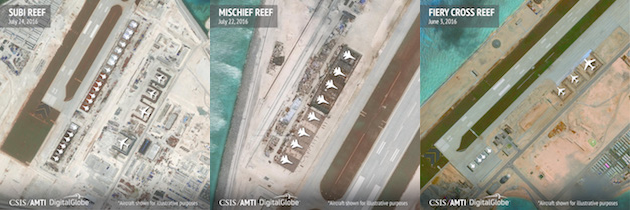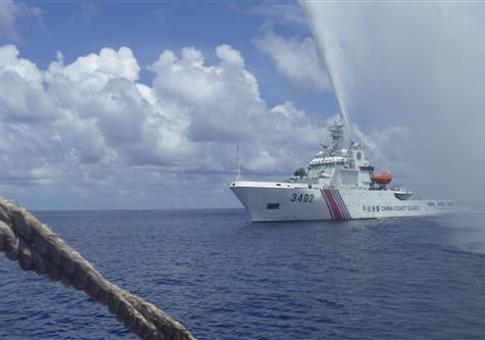China is building up maritime security forces around a key disputed island in the South China Sea that the Pentagon has warned China not to militarize.
According to Pentagon officials, the number of Chinese maritime security vessels near Scarborough Shoal, in the Spratly Islands, has risen sharply over the past several weeks.
For the past several years, China has limited the deployment of naval vessels at Scarborough Shoal to two or three maritime security ships that are similar to coast guard ships.
Over the past several weeks, however, the number of Chinese warships there has increased to more than a dozen, said officials familiar with intelligence reports.
Furthermore, China appears to be sending a large flotilla of hundreds of fishing vessels to Scarborough Shoal in an action similar to what is currently taking place in the East China Sea.
China has sent a total of 324 fishing vessels to waters around Japan’s Senkaku Islands, along with 13 maritime security ships. That fishing fleet deployment is based on China’s claim to sovereignty over the Senkakus, which Beijing calls the Diaoyu Islands.
Japan’s government protested the Chinese fishing incursions. "The situation surrounding the Japan-China relationship is significantly deteriorating," Japanese Foreign Minister Fumio Kishida said in a statement Tuesday. "We cannot accept that [China] is taking actions that unilaterally raise tensions."
The recent increase in naval vessels at Scarborough Shoal coincided with other provocative Chinese military activities throughout the South China Sea that have been underway since the United Nations Permanent Court of Arbitration ruled July 12 against China’s expansive sovereignty claims there.
The court backed Philippines in the maritime dispute, while Beijing rejected the ruling as lacking legal jurisdiction. China is claiming 90 percent of the South China Sea, a water bridge between the Indian and Pacific Oceans where some $5.3 trillion in trade transits annually.
For the past decade, China has been seeking to take over the entire sea claiming it is historically Chinese maritime territory.
Earlier this week, Chinese H-6K bombers and Su-30 fighter aircraft conducted patrols over the sea, including Scarborough Shoal, according to Chinese state media.
A Pentagon spokesman had no immediate comment.
The increased naval activity is a new development. Adm. Harry Harris, commander of the U.S. Pacific Command, told the Wall Street Journal last week that "there hasn’t been any demonstrable change in Chinese behavior around [Scarborough] in terms of dredging or any of that activity."
"So I think we’re at a place where truly we have to wait and see," Harris said.
In February, Secretary of State John Kerry questioned Chinese Foreign Minister Wang Yi about Chinese plans to build up Scarborough Shoal.
The Kerry inquiry followed U.S. intelligence reports that China is preparing to conduct island building at the shoal and has contracted with a Chinese company for dredging equipment.
The recent Chinese naval activities on the South China Sea shoal are likely to increase U.S.-China tensions. In June, Defense Secretary Ash Carter said Chinese militarization on Scarborough Shoal would be a red line China should not cross.
Asked about a potential Chinese military buildup on Scarborough Shoal, Carter said June 4: "I hope that this development doesn't occur because it will result in actions being taken by both United States and by others in the region which would have the effect of not only increasing tensions but isolating China."
Military experts believe the increase in the Chinese military presence at Scarborough could be the first step in China conducting land reclamation of the disputed island located close to where U.S. military forces will be deployed in the Philippines, which claims the Spratlys as its territory.
The last time China sent large number of naval ships to Scarborough Shoal was April 2012, when over 10 vessels were deployed. The vessels set up a security cordon around the shoal and prevented the Philippines from transiting waters nearby.
That Chinese control over Scarborough Shoal has continued since 2012.
"The increased presence of Chinese military vessels at Scarborough Shoal may indicate that Beijing has now decided to start the process of reclaiming land in and around the Shoal in order to establish a larger military presence at the northern entrance to the South China Sea," said retired Navy Capt. Jim Fanell, a former Pacific Fleet intelligence chief.
"If these vessels are in place, the U.S. Navy will have a hard time displacing them once the reclamation process begins as dredging ships arrive to begin their work," Fanell added. "Increased U.S. and allied reconnaissance that flies directly over the shoal should be conducted and the results shared with the press to either confirm or deny the activities by the [People’s Republic of China]."
Disclosure of the massing of naval forces at Scarborough Shoal comes amid new satellite imagery showing China has deployed fighter aircraft with permanent storage and maintenance hangars at three other Spratly Islands.
The imagery, made public by the Center for Strategic and International Studies, reveals that aircraft hangars were rapidly built on Fiery Cross, Subi, and Mischief reefs—three island bases that the Pentagon has said are part of a triangle of Chinese military facilities.

The three islets are being prepared for hangar space for 24 fighter jets along with three to four larger planes.
Contrary to press reports, the hangars are not hardened against attack. Instead, the aircraft storage facilities are fortified against the frequent storms that pass through the South China Sea.
A defense official said the new warplane facilities represent a significant buildup on the islands because the hangars can be used to service and repair China’s jet forces, which can now be permanently stationed there.
"In the past, they had to return to the mainland for maintenance," the official said.
